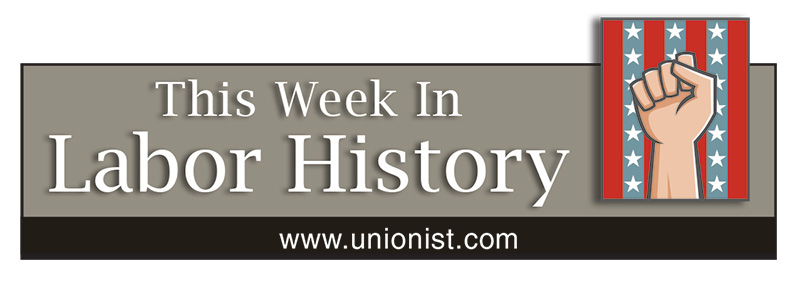
FEBRUARY 27
1875 – Legendary Labor leader and socialist presidential candidate Eugene V. Debs becomes charter member and secretary of the Vigo Lodge, Brotherhood of Locomotive Firemen. Five years later he is leading the national union and in 1893 helps found the nation’s first industrial union, the American Railway Union.
1932 – Thirty-eight miners die in a coal mine explosion in Boissevain, Va.
1937 – Four-hundred-fifty Woolworth’s workers and customers occupy store for eight days in support of Waiters and Waitresses Union, Detroit.
1939 – The Supreme Court rules that sit-down strikes, a major organizing tool for industrial unions, are illegal.
1943 – Mine disaster kills 75 at Red Lodge, Mont.
FEBRUARY 28
1898 – U.S. Supreme Court finds that a Utah state law limiting mine and smelter workers to an eight-hour workday is constitutional.
1938 – A 15-week strike in San Francisco by 108 members of the ILGWU’s “Chinese Ladies Garment Workers Union” was started against a National Dollar Stores factory and three retail stores on Feb. 26, 1938. Two weeks after white retail clerks struck in support, the strike was won. Workers received a pay increase, enforcement of health and safety regulations, and guarantees of work. Although the company closed a year later, the union later helped Chinese workers get positions in previously white-only shops, and some moved into leadership positions in the ILGWU.
1948 – (Actually leap year Feb. 29) Screen Actors Guild member Hattie McDaniel becomes the first African-American to win an Academy Award, honored for her portrayal of “Mammy” in “Gone with the Wind.”
1986 – In response to the layoff of 450 union members at a 3M factory in New Jersey, every worker at a 3M factory in Elandsfontein, South Africa, walks off the job in sympathy.
MARCH 1
1900 – The Granite Cutters National Union begins what is to be a successful nationwide strike for the eight-hour day. Also won: union recognition, wage increases, a grievance procedure and a minimum wage scale.
1907 – IWW strikes Portland, Ore., sawmills.
1936 – Sailors aboard the S.S. California, docked in San Pedro, Calif., refuse to cast off the lines and allow the ship to sail until their wages are increased and overtime paid. The job action lasts three days before the Secretary of Labor intervenes and an agreement is reached. The leaders were fined two days’ pay, fired and blacklisted, although charges of mutiny were dropped. The action marked the beginnings of the National Maritime Union.
1936 – After five years of labor by 21,000 workers, 112 of whom were killed on the job, the Hoover Dam (Boulder Dam) is completed and turned over to the government. Citizens were so mad at President Herbert Hoover, for whom the dam had been named, that it was later changed to Boulder Dam, being located near Boulder City, Nev.
1937 – CIO president John L. Lewis and U.S. Steel President Myron Taylor sign a landmark contract in which the bitterly anti-union company officially recognized the CIO as sole negotiator for the company’s unionized workers. Included: the adoption of overtime pay, the 40-hour work week and a big pay hike.
MARCH 2
1913 – Postal workers granted eight-hour day.
1990 – More than 6,000 drivers strike Greyhound Lines, most lose jobs to strikebreakers after company declares an “impasse” in negotiations.
MARCH 3
1906 – The local lumber workers’ union in Humboldt County, Calif., founded the Union Labor Hospital Association to establish a hospital for union workers in the county. The hospital became an important community facility that was financed and run by the local Labor Movement.
1915 – Congress approves the Seamen’s Act, providing the merchant marine with rights similar to those gained by factory workers. Action on the law was prompted by the sinking of the Titanic three years earlier. Among other gains, working hours were limited to 56 per week, and guaranteed minimum standards of cleanliness and safety were put in place.
1931 – The Davis-Bacon Act took effect today. It orders contractors on federally financed or assisted construction projects to pay wage rates equal to those prevailing in local construction trades.
MARCH 4
1801 – In his inaugural address, President Thomas Jefferson declares: “Take not from the mouth of labor the bread it has earned.”
1913 – President William Howard Taft signs legislation creating the Department of Labor. Former United Mine Workers Secretary-Treasurer William B. Wilson is named to lead the new department.
1933 – President Franklin D. Roosevelt names a woman, Frances Perkins, to be Secretary of Labor. Perkins became the first female cabinet member in U.S. history.
1989 – Machinists strike Eastern Airlines, are soon joined by flight attendants and pilots in the nationwide walkout. Owner Frank Lorenzo refuses to consider the unions’ demands. Eastern ultimately went out of business.
MARCH 5
1770 – British soldiers, quartered in the homes of colonists, took the jobs of working people when jobs were scarce. On this date, grievances of rope makers against the soldiers led to a fight. Soldiers shot down Crispus Attucks, a Black colonist, then others, in what became known as the Boston Massacre. Attucks is considered the first casualty in the American Revolution.
1979 – United Shoe Workers of America merge with Amalgamated Clothing & Textile Workers Union.
(Compiled by David Prosten, founder of Union Communication Services)

